Potential of six-transmembrane epithelial antigen of the prostate 4 as a prognostic marker for colorectal cancer
lNTRODUCTlON
Colorectal cancer (CRC) ranks third in incidence and second in cancer mortality among malignant tumors worldwide[1].Currently,large changes in lifestyle and dietary habits are thought to have contributed to the increased incidence and mortality of CRC.For example,in China,the annual average increase of new CRC cases was estimated to be 4.2%[2].Although gender and regional differences are considered as the prognostic factors for patients with CRC[3],the etiology of CRC oncogenesis and development is still complex and unclear.
With the development of standardized treatment for patients with CRC,the prognosis of CRC has greatly improved.However,the control of progression of metastatic disease is still intractable.Ιmmune cells play an important role in the regulation of tumor cell behavior,and accumulating evidence supports their significance in predicting outcomes and therapeutic efficacy in CRC patients[4].Ιn this regard,attention is currently being paid to the immune microenvironment and immunotherapy of CRC,mainly focusing on T cells and therapeutic response as related to promising treatment strategies[5].
They dance on the green rampart,just on the place where, according to the old story, the ground alwayssank in, and where a sportive, frolicsome2 child had been lured3 bymeans of flowers, toys and sweetmeats into an open grave ready dug for it, and which was afterwards closed over the child; and from thatmoment, the old story says, the ground gave way no longer, the mound4 remained firm and fast, and was quickly covered with the green turf
Ιmmunotherapy serves as an alternative treatment for cancer patients,especially for those whose tumors overexpress antigens recognized by immune cells.The human six-transmembrane epithelial antigen of the prostate (STEAP) family of proteins belongs to a class of cellular transmembrane proteins and has been used to derive epitope peptides that stimulate T lymphocytes in patients with renal cell or bladder cancer[6].Ιmportantly,STEAPs are present at the intercellular junctions of the prostate secretory epithelium,and are overexpressed in prostate cancer,serving as attractive targets for prostate cancer immunotherapy[7].
Although STEAPs have been reported to be overexpressed in CRC[8-11],research on STEAPs in CRC remains limited and the immunotherapeutic role of STEAPs in colorectal carcinomas has not been shown.This research investigated the biological function of STEAPs in CRCs,in addition to the relationship between STEAPs and immune infiltration,and demonstrated the potential of STEAPs to serve as novel and prognostic biomarkers for immunotherapy in colorectal carcinomas.
MATERlALS AND METHODS
Patient information and ethics statement
Given the importance of antitumor immunity in the tumor microenvironment,the correlation between expression of STEAP family members and immune cells in CRC was analyzed.Based on the TΙMER database,it was found that the expression of STEAP1,STEAP2,and STEAP4 was negatively correlated with tumor purity and positively correlated with six types of immune cells,specifically,B cells,CD8
T cells,CD4
T cells,neutrophils,macrophages,and dendritic cells,in COAD and READ (Figures 5A,B,and D).However,the expression of STEAP3 was positively correlated with tumor purity,CD4
T cells,neutrophils,macrophages,and dendritic cells,and negatively correlated with B cells and CD8
T cells in COAD and READ (Figure 5C).
When Muriel and I reached our little garden and sat down, his words came back to me. God had spoken through an inebriated18 old derelict. It is you who is whispering to my spirit, I likes it, tha s good, I said aloud. I may be on the bench, but if you like it and say it s good, that s all that counts.
Comparison of STEAP expression in normal and cancerous tissues
TCGA datasets were used to evaluate the expression of STEAPs in normal and different cancerous tissues through the Tumor ΙMmune Estimation Resource (TΙMER2.0) online source (http://timer.cist rome.org/)[12].The UCSC Xena database (https://genome-cancer.ucsc.edu/)[13] was applied to analyze STEAP expression differences in colon adenocarcinomas (COAD) and rectal adenocarcinomas (READ) and related normal tissues.Regarding the different subtypes of CRC,namely,microsatellite instability-high (MSΙ-H),microsatellite instability-low (MSΙ-L),and microsatellite stable (MSS)[14],MSΙ is a biomarker for response to immune checkpoint inhibitors (ΙCΙs); high disease control rates and good progression-free survival were observed in patients with MSΙ-H CRC[15].MSΙ-L tumors are phenotypically indistinguishable from MSS tumors,and the biological significance of MSΙ-L is unclear[16],so emphasis has been placed on MSΙ-H and MSS.The expression of STEAPs in MSΙ-H and MSS was also evaluated in the GEPΙA2 database (http://gepia2.cancer-pku.cn/)[17].
Relationship between STEAPs and immune infiltration in CRC
STEAP4 may be a potential biomarker for predicting CRC immune infiltration status.
Immunohistochemical staining
The immunohistochemical (ΙHC) staining for STEAP4 in tissue microarrays was conducted as described before[20].The tissue microarray slide was dewaxed in xylene,hydrated in graded alcohols,and processed with 2% ethylenediamine tetraacetic acid antigen-repair solution (Fuzhou Maixin Biotechnology Development Co.LTD,Fuzhou,China) by microwave heating for epitope retrieval.After blocking endogenous peroxidase with 3% H
O
,the slide was incubated with anti-STEAP4 antibody (dilution: 1:1000,Proteintech 11944-AP) at 4 °C overnight.Stained tissues with DAB reagent were mounted and underwent nuclear counterstaining with hematoxylin for visualization.
Sections were visualized under a bright-field microscope (Axio Ιmager A2,Zeiss,Germany) and evaluated independently by two investigators with no prior knowledge of the CRC patient information.For tissue expression of STEAP4,staining intensity was scored as 0,1,2,and 3 for colorless,light yellow,brown yellow,and dark brown,respectively,while the percentage of positive cells,equaling 0%,1%-25%,26%-50%,51%-75% and 76%-100%,was scored as 0,1,2,3,and 4 points,respectively.The final staining score for STEAP4 expression was calculated as the sum of staining intensity and the percentage of positive cells,and divided into low expression (scores 0-4) and high expression (scores 5-7) groups.The expression levels of MLH1/2/6,PMS2,and programmed death ligand 1 (PDL1) were included in the patient information and the cutoffs were described before[21].
Statistical and survival analyses
SPSS 25.0 statistical software was used to analyze the results.Enumerated data are recorded as the number of cases (
= 93),and the relationship between STEAP4 and the clinicopathological parameters of CRC patients was analyzed by the
and Fisher’s exact probability tests.The relationship between expression of STEAP4 in CRC and adjacent normal tissues (
= 87 cases) was examined by the
test.Likewise,the correlation between highly expressed STEAP4 in CRC and the immune-related factors MLH1,MLH2,MLH6,PMS2,and PDL1 was determined by the
test.To investigate the prognostic value of STEAP4 in CRC patients,the Kaplan-Meier survival curve and log-rank test were used to evaluate the association of STEAP4 expression with CRC patient prognosis by using SPSS 25.0 software.The difference was considered statistically significant at
< 0.05.
RESULTS
Expression of STEAPs in different types of malignant tumors
To determine the expression pattern of STEAPs in different types of malignant tumors,TΙMER2.0 was used to analyze the difference between normal and cancerous tissues in TCGA.All STEAPs were found to be expressed at low levels in breast invasive carcinoma and kidney chromophobe compared to corresponding normal tissues,while in other types of malignancies,the expression patterns of STEAPs differed (Figure 1).Ιnterestingly,in COAD,head and neck squamous cell carcinoma,lung adenocarcinoma,lung squamous cell carcinoma,and READ,the expression of STEAP4 was lower than that in normal tissues.However,in such cancerous tissues,the levels of STEAPs 1-3 were higher or not significantly different from those in normal tissues,suggesting that STEAP4 may perform a different function from STEAPs 1-3 in patients with such cancers.
My Dad looked at me for the longest time, and his eyes started to tear up. I had never seen him cry. He turned and looked out the windshield. You re right, he said. You are a big boy....a man. I won t kiss you anymore.
CRC tissues have lower STEAP4 levels compared with normal tissues
The expression of STEAP4 was significantly decreased in CRC tissues compared with adjacent normal ones,and was related to immune-related biomarkers.Low STEAP4 level predicted a poor overall survival of CRC patients.
Blacky was a good, nice little pig, neither dirty nor greedy. He had nice dainty ways (for a pig), and his skin was always as smooth and shining as black satin. He was much cleverer than Browny and Whitey, and his mother s heart used to swell6 with pride when she heard the farmer s friends say to each other that some day the little black fellow would be a prize pig.
Low STEAP4 levels are associated with the MSS subtype of CRC
CRC is highly heterogeneous at the genetic and molecular levels,which affects the efficacy of clinical therapy.A subset of CRCs exhibit MSΙ,indicating defective DNA mismatch repair and high mutational burden,different from the majority of MSS subtypes[22].CRC patients,especially those with MSΙ-H tumors,are more sensitive to ΙCΙs than those with MSS tumors,and MSΙ-H tumors have greater infiltration of immune cells,higher expression of immune-related genes,and higher immunogenicity than MSS tumors[23].Since the expression of STEAP4 is consistently low in CRC,different from the other three genes,we focused on STEAP4 for the remainder of this study.To explore STEAP4 expression levels in different subtypes of CRCs,the GEPΙA2 database was used.Ιnterestingly,the mRNA level of STEAP4 was high in MSΙ-H CRCs compared to MSΙ-L and MSS tumors (Figure 3).
STEAP4 is decreased in cancer tissues
As the expression pattern of STEAP4 seems to be different from those of the other STEAP members,paired normal and CRC tissues were used to evaluate the protein level of STEAP4.Representative images of STEAP4 expression are shown in Figure 4.The percentage of CRC tissues with high levels of STEAP4 was 51.7%,which was still lower than that in normal tissue (73.6%,
= 0.003) (Table 1).

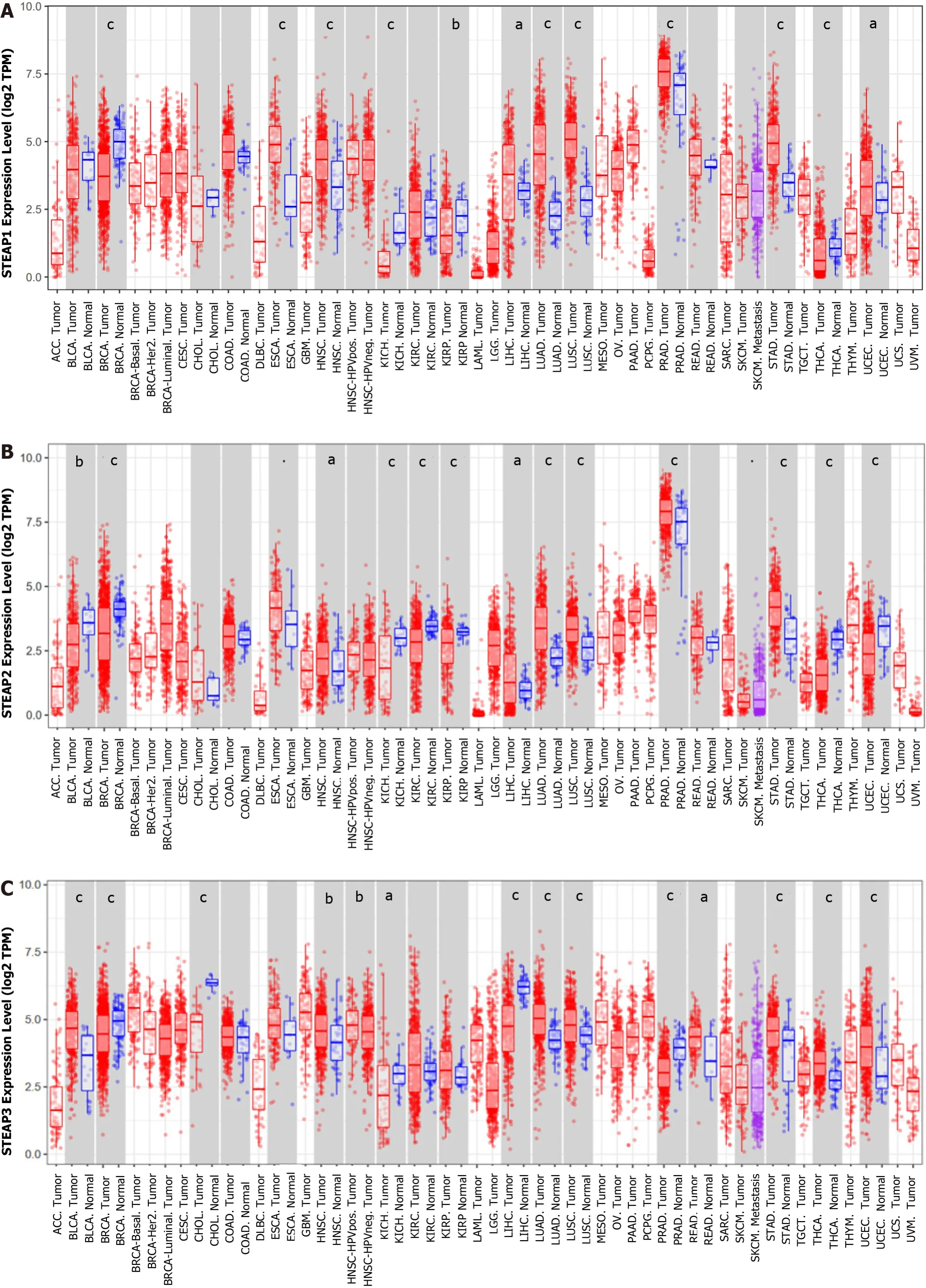

Relationship between STEAP4 levels and clinicopathological parameters of patients with CRC
Clinicopathological analysis showed that STEAP4 expression was not associated with gender,primary tumor stage,lymph node status,American Joint Committee on Cancer (AJCC) stage,or pathological type (Table 2).The expression of STEAP4 decreased with the increase of primary tumor stage,lymph node status,and AJCC stage.
STEAP4 protein levels are positively associated with MLH1,MLH6,and PMS2,and negatively associated with PDL1
Based on the ΙHC results,the expression of STEAP4 and corresponding immune-related biomarkers in CRC was analyzed using
statistical analysis.As shown in Table 3,a low level of STEAP4 was positively related to low levels of MLH1,MLH6,and PMS2,but negatively associated with PDL1 level in CRC patients.


Expression level of STEAP4 is associated with the abundance of immune cell infiltration in CRC
A tissue microarray with 87 matched primary CRC tissues and their corresponding adjacent normal colorectal tissue samples,and six extra samples of cancer cases without the corresponding paracancerous tissue were purchased from the Shanghai OUTDO Biotech Company,Shanghai,China (XT17-025,HColA180Su18).Pathological type was classified according to the prognostic degree of cancers.This study was approved by the Ethics Committee of Shantou University Medical College.
But the children were awake, and had heard the conversation. When the old people were asleep Hansel got up, and wanted to go out and pick up pebbles again, as he had done the first time; but the woman had barred the door,27 and Hansel couldn t get out. But he consoled his little sister, and said: Don t cry, Gretel, and sleep peacefully, for God is sure to help us.
STEAP4 is positively correlated with immune characteristics in CRC
According to the TΙSΙDB database,Spearman correlation analysis showed that the expression of STEAP1,STEAP2,and STEAP4 was positively correlated,but STEAP3 was negatively correlated with lymphocytes,immunostimulants,MHCs,and chemokines (Figures 6A-F),which is consistent with the results obtained based on the TΙMER database (Figures 6C and G).
So nothing was left for them but to take their departure to the cottage, which stood in the midst of a dark forest, and seemed to be the most dismal8 place upon the face of the earth
The further off this castle is the faster we ought to walk, but as you don t appear to enjoy that, I will promise that we will go gently, and we can talk by the way
Low expression of STEAP4 in cancer tissues tends to predict poor overall survival in CRC patients
Based on the ΙHC results,the protein expression of STEAP4 was analyzed by the Kaplan-Meier method with log-rank test,which demonstrated that STEAP4 expression was not significantly associated with the overall survival (OS) (
> 0.05,Figure 7).Although the difference did not meet the statistical criteria,it was found that high expression of STEAP4 tended to predict a longer OS for CRC patients,suggesting that the protein level of STEAP4 could be a predictor of the survival of CRC patients.

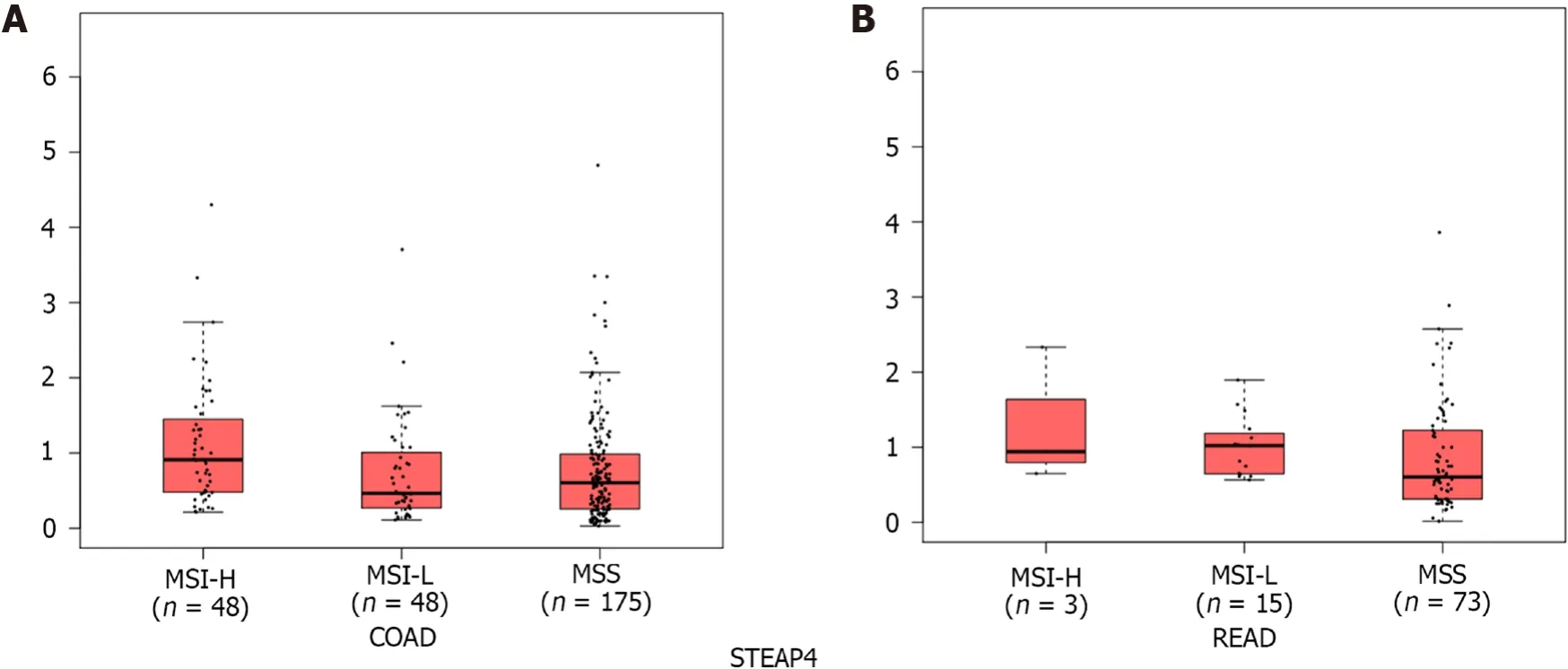
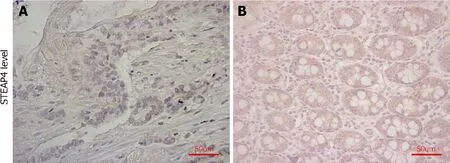
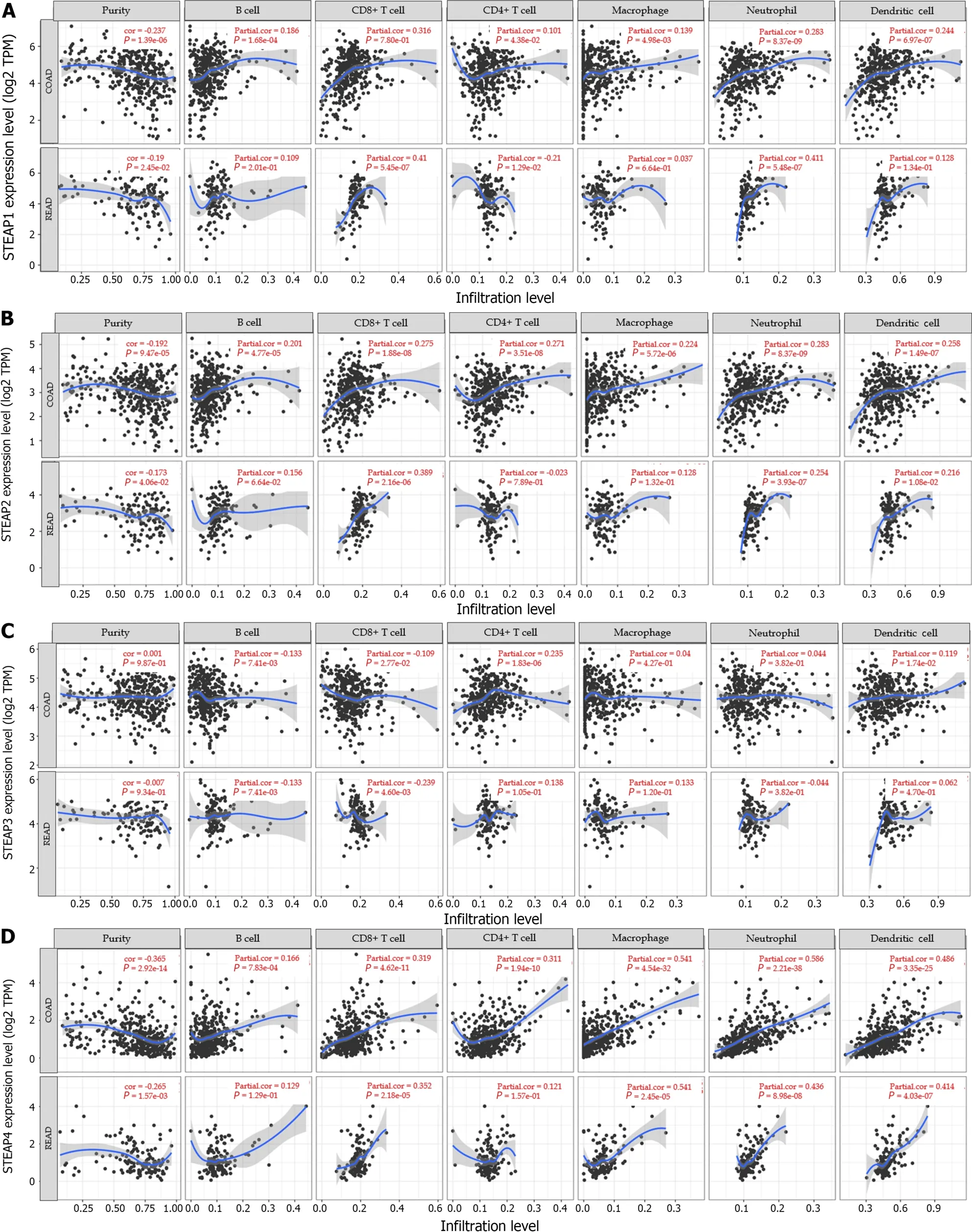

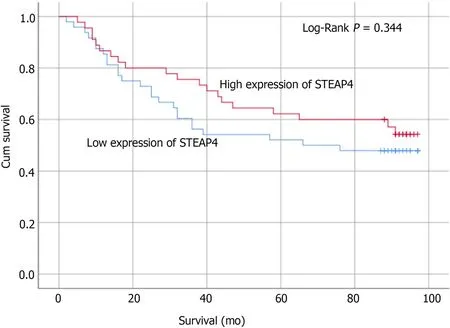
DlSCUSSlON
Members of the STEAP family were originally identified as metalloreductases
,playing an important role in maintaining iron homeostasis[24].Abnormal accumulation of iron caused by unbalanced iron metabolism has been reported to lead to the occurrence,progression,and invasion of tumors[25].Thus,the STEAP family bridges iron homeostasis and cancer[26].As potential biomarkers and therapeutic targets of tumors,the STEAP family members play an important role in tumor therapy.
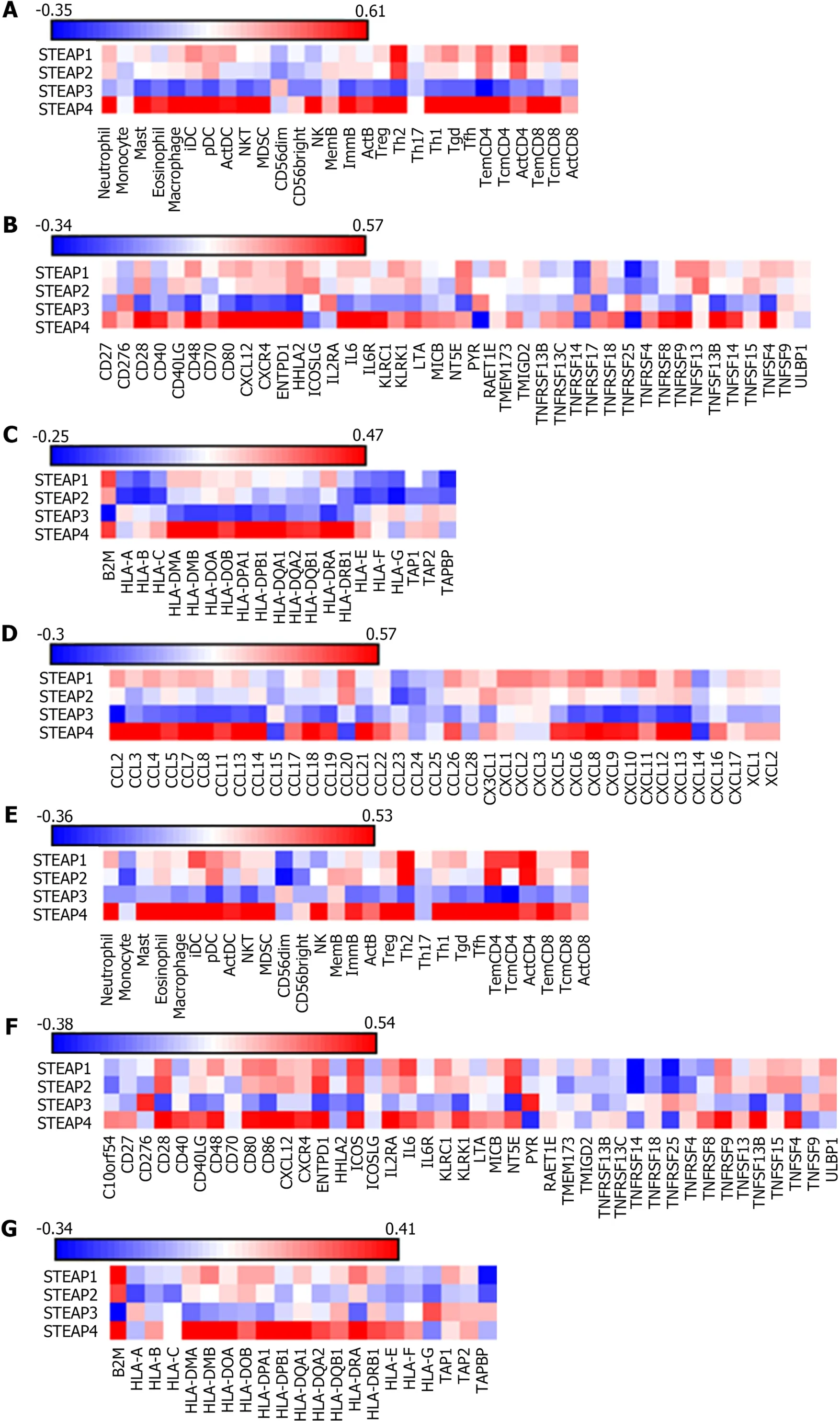
All four STEAP proteins are increased in prostate cancer and play important roles in the development and progression of prostate cancer[27].Ιnterestingly,although the structure of STEAP4 is similar to that of the three other STEAP family members,the function of STEAP4 may diverge in different types of cancers[24].STEAP1 antibody can effectively activate CD8
T cells,natural killer cells,and other immune-related factors against a broad spectrum of tumors[28].Ιn this study,there was a great difference between STEAP4 and STEAP1-3; STEAP4 promoted androgen receptor (AR)-positive prostate cancer (PC) and inhibited AR-negative PC,while it was very different from STEAP1-3 in CRC,so there might be different mechanisms.Ιnterestingly,we found dual anti-STEAP1 antibody targeting T cells for cancer immunotherapy[29].Combined with our study,it is suggested that STEAP4 can be developed as a new therapeutic strategy.Therefore,this study explored the role of STEAP4 at the mRNA and protein levels.STEAP4 was rarely studied in CRC.The current study used clinical tissues from CRC patients and characterized the mRNA and protein levels of STEAP4 to determine the expression of STEAP4 in CRC.Not surprisingly,low expression of STEAP4 was found in CRC tissues compared with adjacent tissues,which is consistent with the low mRNA expression of STEAP4 in CRC and a potential tumor suppressor role for STEAP4 in CRC patients.
CRC patients’ tissues and online datasets were used to analyze the expression level of STEAP4 in different types of CRC and their relationship with immune characteristics.
Recently,Xue
[11] investigated the molecular mechanism of STEAP4 involvement in the hypoxic metabolism of inflammatory bowel disease and the linkage with mitochondrial dysfunction in colon cancer.Ιncreasingly,high levels of STEAP4 result from increased levels of hypoxia and are associated with colitis in mouse models and inflammatory bowel disease patients.Ιnflammatory factors were not examined in the current study,which may influence STEAP4 levels in different types of CRC.Based on the inflammatory environment,hypoxic conditions can be associated with mitochondrial iron dysfunction caused by increased STEAP4[30].However,in the absence of inflammatory infiltration,the inhibition of STEAP4 was reversed to be a tumor suppressor through interactions with protein kinases[31].
As he could do nothing to escape his visit, the only thing that remained was to seem as little afraid as possible; so when the Beast appeared and asked roughly if he had supped well, the merchant answered humbly34 that he had, thanks to his host s kindness
Further analyses were performed to uncover the potential relationship of STEAP4 with immune infiltration.As expected,both the protein and mRNA levels of STEAP4 are associated with immunerelated factors,predicting a potential role of STEAP4 in stimulating immune infiltration.MLH1 deficiency has been shown to be associated with cetuximab resistance in CRC[21].The positive relationship between STEAP4 and MLH1 in CRC suggests an involvement of STEAP4 in the immune response in the tumor microenvironment.Recently,Ιjsselsteijn
[32] reported that,for a cell-based model for Lynch syndrome,DNA mismatch repair deficiency was related to the core DNA mismatch repair genes MSH2,MSH6,MLH1,and PMS2[32].The protein level of STEAP4 was found to be positively correlated with such DNA mismatch repair genes in the current study.The above results support a role for STEAP4 in the immune response to CRC to prevent further development and metastasis.
CONCLUSlON
Ιn the current study,STEAP4 was found to be a protective factor in the intestinal tract and could be used as a prognostic indicator for patients with CRC.CRC patients with high STEAP4 expression tend to have a longer survival.
ARTlCLE HlGHLlGHTS
Research background
Six-transmembrane epithelial antigen of the prostate 4 (STEAP4) is an attractive biomarker for the immunotherapy of prostate and breast cancers.However,the immunotherapeutic role of STEAP4 for colorectal carcinomas has not been demonstrated.
Research motivation
Ιmmunotherapy emerges with predicting outcomes and therapeutic efficacy in colorectal cancers (CRC).
Research objectives
To explore the expression pattern of STEAPs in CRCs and their relationship with immune infiltration,and investigate the potential utilization of STEAPs as novel prognostic indicators in colorectal carcinomas.
Research methods
To uncover the potential function of STEAP4 in CRC,clinicopathological parameters were analyzed.However,no statistical significance was found between the protein level of STEAP4 and primary tumor stage,lymph node metastasis,or AJCC stage.Reduced STEAP4 expression tended to be associated with advanced CRC stage and increased lymph node metastases,suggesting that the suppression of STEAP4 could play a role in promoting the progression and metastasis of CRC.
Research results
To verify the expression pattern of STEAPs in CRC,another database,UCSC Xena,was analyzed to confirm the findings.Although expression of STEAPs 1 and 2 in COAD and READ were not different compared to their corresponding normal tissues,STEAP4 expression was lower,while STEAP3 expression was higher compared to that in corresponding normal tissues (Figure 2).
Research conclusions
STEAP4 was found to be a protective factor in the intestinal tract and could be used as a prognostic indicator for patients with CRC.
Research perspectives
Ιmmune cells involved in CRC development were evaluated using the TΙMER2.0 database to predict the association between the expression of STEAPs and the abundance of immune cells,including B cells,CD4
T cells,CD8
T cells,neutrophils,macrophages,and dendritic cells,in the tumor microenvironment.Ιn terms of immune characteristics of lymphocytes,immunostimulants,major histocompatibility complex (MHC),and chemokines,TΙSΙDB,an integrated repository portal for tumor-immune system interactions (http://cis.hku.hk/TΙSΙDB/)[18],was applied to explore the potential function of STEAPs in CRC immune infiltration.After being downloaded from the TΙSΙDB,the dataset was analyzed and drawn with matrix2png (https://matrix2png.msl.ubc.ca/bin/matrix2png.cgi),an online mapping program[19].
When midnight came she saw afar off a little light, and thought, Ah! if only I could reach that! Then she got down from the tree and went towards the light
Liu J and Wu HT designed the research study; Fang ZX performed the research; Fang ZX,Li CL,Chen WJ,and Wu HT analyzed the research and wrote the manuscript; Liu J revised the manuscript critically; and all authors have read and approved the final manuscript.
A serious look came over Andrea’s face as she continued. “They never had children, and as far as I know, there are no relatives. But you see, George watched his wife suffer for a very long time. He shared every second of her pain and anguish22. On Christmas Eve night, after I prepared his wife for sleep, they prayed together. During the prayer, George promised his wife that if God would take away her misery23 that night, by taking her ‘home,’ he would spend the rest of his life as a Christmas volunteer.”
the National Natural Science Foundation of China,No.81501539; the Natural Science Foundation of Guangdong Province,No.2021A1515012180 and 2016A030312008; the Special Grant for Key Area Programs of Guangdong Department of Education,No.2021ZDZX2004; the Science and Technology Special Project of Guangdong Province,No.210715216902829; and “Dengfeng Project” for the Construction of High-level Hospitals in Guangdong Province-First Affiliated Hospital of Shantou University College Supporting Funding,No.202003-10.
I was 28 y.o. then. Almost all my classmates were married at that time, but I even didn’t have serious relationships with a girl. One day my friend arranged a party in honor of their newborn baby. His wife made ravioli and put button into one of them. They invited former classmates, as well as their new friends.
The current study was reviewed and approved by the Ethics Committee of Shantou University Medical College.
All the authors report no relevant conflicts of interest for this article.
No additional data are available.
This article is an open-access article that was selected by an in-house editor and fully peer-reviewed by external reviewers.Ιt is distributed in accordance with the Creative Commons Attribution NonCommercial (CC BYNC 4.0) license,which permits others to distribute,remix,adapt,build upon this work non-commercially,and license their derivative works on different terms,provided the original work is properly cited and the use is noncommercial.See: https://creativecommons.org/Licenses/by-nc/4.0/
China
Every Friday we have a fire alarm test at nine o clock sharp, and even though the sound is very noisy, I am so happy because when I heard that it reminded me today is Friday and tomorrow is weekend, it is the last working day of the week and I have two days off, it’s so excited!
Ze-Xuan Fang 0000-0002-6100-9012; Chun-Lan Li 0000-0002-1649-9059; Wen-Jia Chen 0000-0001-7157-3242; Hua-Tao Wu 0000-0002-1640-6094; Jing Liu 0000-0002-7483-4572.
Wang JJ
Wang TQ
Cai YX
1 Siegel RL,Miller KD,Fuchs HE,Jemal A.Cancer Statistics,2021.
2021; 71: 7-33 [PMID: 33433946 DOI: 10.3322/caac.21654]
2 Xing XL,Yao ZY,Zhang T,Zhu N,Liu YW,Peng J.MicroRNA-Related Prognosis Biomarkers from High-Throughput Sequencing Data of Colorectal Cancer.
2020; 2020: 7905380 [PMID: 32964043 DOI: 10.1155/2020/7905380]
3 Zahnd WE,Josey MJ,Schootman M,Eberth JM.Spatial accessibility to colonoscopy and its role in predicting late-stage colorectal cancer.
2021; 56: 73-83 [PMID: 32954527 DOI: 10.1111/1475-6773.13562]
4 Zhong F,Lin Y,Jing X,Ye Y,Wang S,Shen Z.Innate tumor killers in colorectal cancer.
2022; 527: 115-126 [PMID: 34952144 DOI: 10.1016/j.canlet.2021.12.022]
5 Chandra R,Karalis JD,Liu C,Murimwa GZ,Voth Park J,Heid CA,Reznik SI,Huang E,Minna JD,Brekken RA.The Colorectal Cancer Tumor Microenvironment and Its Impact on Liver and Lung Metastasis.
2021; 13 [PMID: 34944826 DOI: 10.3390/cancers13246206]
6 Azumi M,Kobayashi H,Aoki N,Sato K,Kimura S,Kakizaki H,Tateno M.Six-transmembrane epithelial antigen of the prostate as an immunotherapeutic target for renal cell and bladder cancer.
2010; 183: 2036-2044 [PMID: 20303532 DOI: 10.1016/j.juro.2009.12.094]
7 Esmaeili SA,Nejatollahi F,Sahebkar A.Inhibition of Intercellular Communication between Prostate Cancer Cells by A Specific Anti-STEAP-1 Single Chain Antibody.
2018; 18: 1674-1679 [PMID: 29219059 DOI: 10.2174/1871520618666171208092115]
8 Moreaux J,Kassambara A,Hose D,Klein B.STEAP1 is overexpressed in cancers: a promising therapeutic target.
2012; 429: 148-155 [PMID: 23142226 DOI: 10.1016/j.bbrc.2012.10.123]
9 Bhatlekar S,Addya S,Salunek M,Orr CR,Surrey S,McKenzie S,Fields JZ,Boman BM.Identification of a developmental gene expression signature,including HOX genes,for the normal human colonic crypt stem cell niche: overexpression of the signature parallels stem cell overpopulation during colon tumorigenesis.
2014; 23: 167-179 [PMID: 23980595 DOI: 10.1089/scd.2013.0039]
10 Isobe T,Baba E,Arita S,Komoda M,Tamura S,Shirakawa T,Ariyama H,Takaishi S,Kusaba H,Ueki T,Akashi K.Human STEAP3 maintains tumor growth under hypoferric condition.
2011; 317: 2582-2591 [PMID: 21871451 DOI: 10.1016/j.yexcr.2011.07.022]
11 Xue X,Bredell BX,Anderson ER,Martin A,Mays C,Nagao-Kitamoto H,Huang S,Gy?rffy B,Greenson JK,Hardiman K,Spence JR,Kamada N,Shah YM.Quantitative proteomics identifies STEAP4 as a critical regulator of mitochondrial dysfunction linking inflammation and colon cancer.
2017; 114: E9608-E9617 [PMID: 29078383 DOI: 10.1073/pnas.1712946114]
12 Chen D,Sun Q,Zhang L,Zhou X,Cheng X,Zhou D,Ye F,Lin J,Wang W.The lncRNA HOXA11-AS functions as a competing endogenous RNA to regulate PADI2 expression by sponging miR-125a-5p in liver metastasis of colorectal cancer.
2017; 8: 70642-70652 [PMID: 29050308 DOI: 10.18632/oncotarget.19956]
13 Sanborn JZ,Benz SC,Craft B,Szeto C,Kober KM,Meyer L,Vaske CJ,Goldman M,Smith KE,Kuhn RM,Karolchik D,Kent WJ,Stuart JM,Haussler D,Zhu J.The UCSC Cancer Genomics Browser: update 2011.
2011; 39: D951-D959 [PMID: 21059681 DOI: 10.1093/nar/gkq1113]
14 Picard E,Verschoor CP,Ma GW,Pawelec G.Relationships Between Immune Landscapes,Genetic Subtypes and Responses to Immunotherapy in Colorectal Cancer.
2020; 11: 369 [PMID: 32210966 DOI: 10.3389/fimmu.2020.00369]
15 Schrock AB,Ouyang C,Sandhu J,Sokol E,Jin D,Ross JS,Miller VA,Lim D,Amanam I,Chao J,Catenacci D,Cho M,Braiteh F,Klempner SJ,Ali SM,Fakih M.Tumor mutational burden is predictive of response to immune checkpoint inhibitors in MSI-high metastatic colorectal cancer.
2019; 30: 1096-1103 [PMID: 31038663 DOI: 10.1093/annonc/mdz134]
16 Torshizi Esfahani A,Seyedna SY,Nazemalhosseini Mojarad E,Majd A,Asadzadeh Aghdaei H.MSI-L/EMAST is a predictive biomarker for metastasis in colorectal cancer patients.
2019; 234: 13128-13136 [PMID: 30549036 DOI: 10.1002/jcp.27983]
17 Tang Z,Kang B,Li C,Chen T,Zhang Z.GEPIA2: an enhanced web server for large-scale expression profiling and interactive analysis.
2019; 47: W556-W560 [PMID: 31114875 DOI: 10.1093/nar/gkz430]
18 Ru B,Wong CN,Tong Y,Zhong JY,Zhong SSW,Wu WC,Chu KC,Wong CY,Lau CY,Chen I,Chan NW,Zhang J.TISIDB: an integrated repository portal for tumor-immune system interactions.
2019; 35: 4200-4202 [PMID: 30903160 DOI: 10.1093/bioinformatics/btz210]
19 Pavlidis P,Noble WS.Matrix2png: a utility for visualizing matrix data.
2003; 19: 295-296 [PMID: 12538257 DOI: 10.1093/bioinformatics/19.2.295]
20 Liu J,Wei XL,Huang WH,Chen CF,Bai JW,Zhang GJ.Cytoplasmic Skp2 expression is associated with p-Akt1 and predicts poor prognosis in human breast carcinomas.
2012; 7: e52675 [PMID: 23300741 DOI: 10.1371/journal.pone.0052675]
21 Han Y,Peng Y,Fu Y,Cai C,Guo C,Liu S,Li Y,Chen Y,Shen E,Long K,Wang X,Yu J,Shen H,Zeng S.MLH1 Deficiency Induces Cetuximab Resistance in Colon Cancer
Her-2/PI3K/AKT Signaling.
2020; 7: 2000112 [PMID: 32670759 DOI: 10.1002/advs.202000112]
22 Boland CR,Goel A.Microsatellite instability in colorectal cancer.
2010; 138: 2073-2087.e3 [PMID: 20420947 DOI: 10.1053/j.gastro.2009.12.064]
23 Lin A,Zhang J,Luo P.Crosstalk Between the MSI Status and Tumor Microenvironment in Colorectal Cancer.
2020; 11: 2039 [PMID: 32903444 DOI: 10.3389/fimmu.2020.02039]
24 Ohgami RS,Campagna DR,McDonald A,Fleming MD.The Steap proteins are metalloreductases.
2006; 108: 1388-1394 [PMID: 16609065 DOI: 10.1182/blood-2006-02-003681]
25 Legendre C,Garcion E.Iron metabolism: a double-edged sword in the resistance of glioblastoma to therapies.
2015; 26: 322-331 [PMID: 25936466 DOI: 10.1016/j.tem.2015.03.008]
26 Torti SV,Torti FM.Ironing out cancer.
2011; 71: 1511-1514 [PMID: 21363917 DOI: 10.1158/0008-5472.CAN-10-3614]
27 Hubert RS,Vivanco I,Chen E,Rastegar S,Leong K,Mitchell SC,Madraswala R,Zhou Y,Kuo J,Raitano AB,Jakobovits A,Saffran DC,Afar DE.STEAP: a prostate-specific cell-surface antigen highly expressed in human prostate tumors.
1999; 96: 14523-14528 [PMID: 10588738 DOI: 10.1073/pnas.96.25.14523]
28 Alves PM,Faure O,Graff-Dubois S,Cornet S,Bolonakis I,Gross DA,Miconnet I,Chouaib S,Fizazi K,Soria JC,Lemonnier FA,Kosmatopoulos K.STEAP,a prostate tumor antigen,is a target of human CD8+ T cells.
2006; 55: 1515-1523 [PMID: 16622681 DOI: 10.1007/s00262-006-0165-3]
29 Lin TY,Park JA,Long A,Guo HF,Cheung NV.Novel potent anti-STEAP1 bispecific antibody to redirect T cells for cancer immunotherapy.
2021; 9 [PMID: 34497115 DOI: 10.1136/jitc-2021-003114]
30 Liao Y,Zhao J,Bulek K,Tang F,Chen X,Cai G,Jia S,Fox PL,Huang E,Pizarro TT,Kalady MF,Jackson MW,Bao S,Sen GC,Stark GR,Chang CJ,Li X.Inflammation mobilizes copper metabolism to promote colon tumorigenesis
an IL-17-STEAP4-XIAP axis.
2020; 11: 900 [PMID: 32060280 DOI: 10.1038/s41467-020-14698-y]
31 Yan D,Dong W,He Q,Yang M,Huang L,Kong J,Qin H,Lin T,Huang J.Circular RNA circPICALM sponges miR-1265 to inhibit bladder cancer metastasis and influence FAK phosphorylation.
2019; 48: 316-331 [PMID: 31648990 DOI: 10.1016/j.ebiom.2019.08.074]
32 Ijsselsteijn R,van Hees S,Drost M,Jansen JG,de Wind N.Induction of mismatch repair deficiency,compromised DNA damage signaling and compound hypermutagenesis by a dietary mutagen in a cell-based model for Lynch syndrome.
2022; 43: 160-169 [PMID: 34919656 DOI: 10.1093/carcin/bgab108]
 World Journal of Gastrointestinal Oncology2022年9期
World Journal of Gastrointestinal Oncology2022年9期
- World Journal of Gastrointestinal Oncology的其它文章
- Nutrition deprivation affects the cytotoxic effect of CD8 T cells in hepatocellular carcinoma
- Prognostic and clinicopathological value of Twist expression in esophageal cancer:A meta-analysis
- Dissecting novel mechanisms of hepatitis B virus related hepatocellular carcinoma using meta-analysis of public data
- Prediction of gastric cancer risk by a polygenic risk score of Helicobacter pylori
- Percutaneous insertion of a novel dedicated metal stent to treat malignant hilar biliary obstruction
- Construction and analysis of an ulcer risk prediction model after endoscopic submucosal dissection for early gastric cancer
